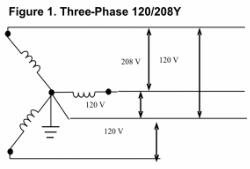Isolation Transformers and Phase Converters
A phase converter generates a third
voltage that is added to single-phase power. Single-phase power is
comprised of two legs with 240V potential between them with ground
and neutral halfway between. Thus, the voltage between L1 and L2
will be 240V, while the voltage to either leg and neutral/ground
will be half that or 120V. The third voltage generated by the phase
converter results in a triangle or delta of three voltages all 240V
apart. However, the ground and neutral are still halfway between
L1and L2. If you measure from the new third leg to ground/neutral,
the voltage will not be 120V, but rather 208V. This is why phase
converters are known to have a “high leg”.

As long as the three-phase load
only derives voltages phase-to-phase, the location of ground/neutral
is irrelevant. However, if the three-phase equipment has internal
120V circuits that are powered by a phase-to-neutral connection,
making this connection between the generated third leg and neutral
would result in a damaging high voltage.
|
For three-phase equipment that
requires a neutral wire connection, the three-phase power must be
converted from a delta configuration to a wye configuration. This
is accomplished with a 240 V delta to 120/208V wye isolation
transformer. This assures that any of the three phase to neutral
voltages will be 120V. Wye power is illustrated in figure 2.

Sizing Transformers
Transformers need to be sized to
the load they will supply and usually rated in KVA, which is an
acronym for “thousand volt amps”. For single-phase loads, multiply
the operating voltage of the load by the amps then divide by 1,000
to get the KVA. e.g. 240V x 30A / 1,000 = 7.2 KVA.
For three-phase loads, multiply the
operating voltage of the load by the amps, multiply by 1.73 (square
root of three) then divide by 1,000 to get the KVA. e.g. 240V x 30A
x 1.73 / 1,000 = 12.46 KVA.
Be sure to consult a
knowledgeable supplier of transformers
when choosing one for your application.
|
|